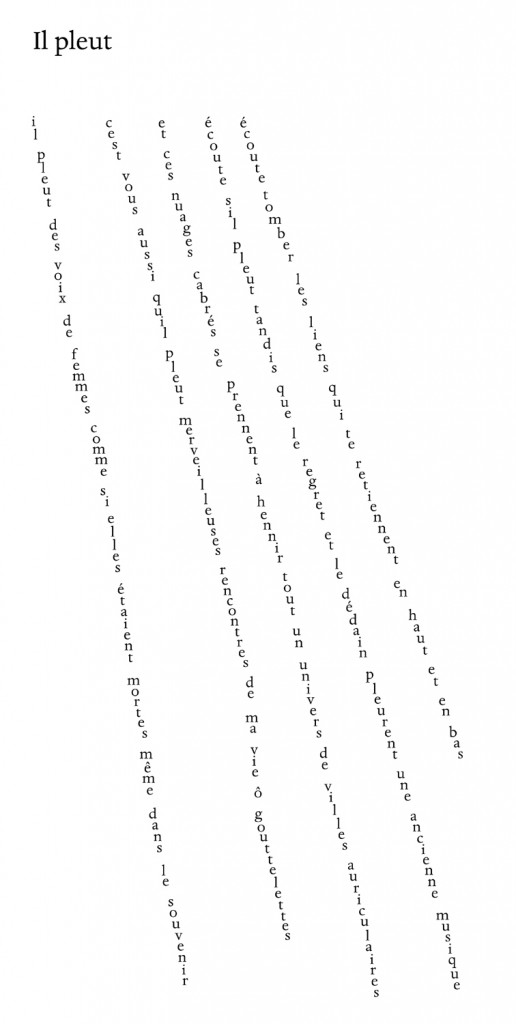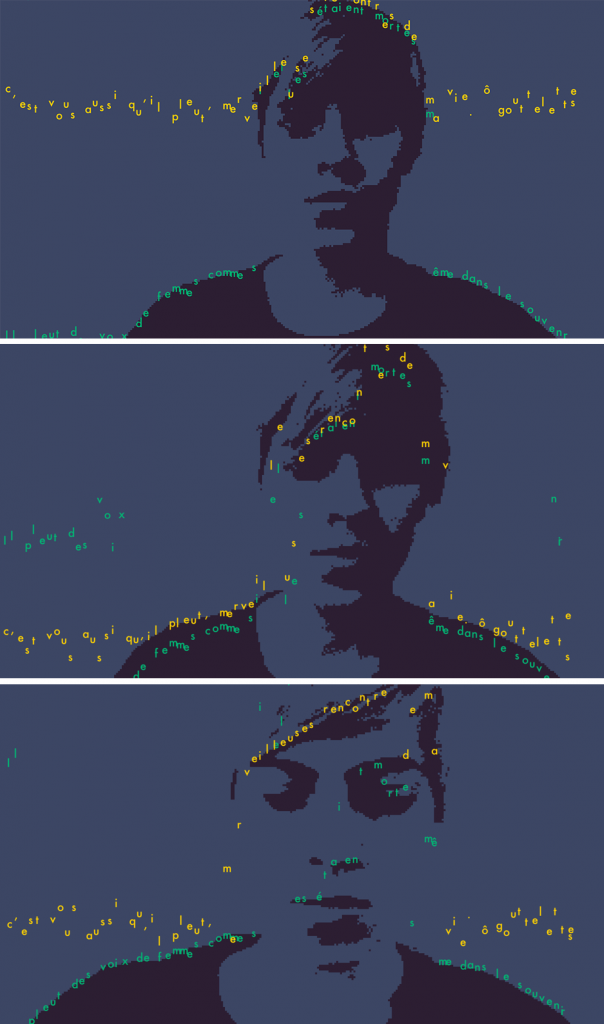Tldr : All the jagged lines in FaceOSC’s mask-thingy made me think of teeth. The fact that I could control something by chewing also made me think of teeth. I really like oceans, bizarre villainous things, and distractingly shiny things. All these facts put together resulted in a Processing approximation of an anglerfish.
Title credit to classmate Kim Harvey, who saw me meddling with this at my desk and promptly exclaimed “It’s like Nemo’s Nightmare…!”
If you don’t know what she’s talking about, here, have some Pixar:
The full implementation of this is in shambles right now. My intent was to create a set of schooling fish that would direct themselves toward the “light”, which is controlled by the coordinates of your nose in FaceOSC. Right now, that doesn’t quite work, but I did manage to create a set of random ‘fishies’ that don’t exactly school but will move toward the approximate location of your nose using the overall facial position coordinates (pos.x, pos.y) instead. The other thing I wanted to do was enable ‘eating’ of the little fishies, by writing some kind of collision detection between them and the (hidden) mouth ellipse.
But like I said in my other post: I am so not that classy yet. If you don’t believe me, check out the scary anglerfish of a code below, or at the GitHub Repo.
// Nemo's Nightmare - a processing app using FaceOSC
// created by Anna von Reden, 2013
// for the IACD Spring 2013 class at the CMU School of Art
//
// created using a template for receiving face tracking osc messages from
// Kyle McDonald's FaceOSC https://github.com/kylemcdonald/ofxFaceTracker
//
// 2012 Dan Wilcox danomatika.com
// for the IACD Spring 2012 class at the CMU School of Art
//
// adapted from from Greg Borenstein's 2011 example
// http://www.gregborenstein.com/
// https://gist.github.com/1603230
//
//TEARDROP CURVE
//M. Kontopoulos (11.2010)
//Based on the parametric equation found at
//http://mathworld.wolfram.com/TeardropCurve.html
//
//STEERING BEHAVIOR
//Based on code examples by iainmaxwell, found here:
// http://www.supermanoeuvre.com/blog/?p=372
import oscP5.*;
OscP5 oscP5;
// num faces found
int found;
// pose
float poseScale;
PVector posePosition = new PVector();
PVector poseOrientation = new PVector();
// gesture
float mouthHeight;
float mouthWidth;
float eyeLeft;
float eyeRight;
float eyebrowLeft;
float eyebrowRight;
float jaw;
float nostrils;
// shape constants & variables
float r = 5;
float a = 5;
ArrayList nemos; // an arraylist to store all of our nemos!
PVector shiny; // The shiny will be the current position of the mouse!
int numnemos = 50;
int stageWidth = 640; // size of the environment in the X direction
int stageHeight = 480; // size of the environment in the Y direction
void setup() {
size(stageWidth, stageHeight, P3D);
frameRate(30);
nemos = new ArrayList(); // make our arraylist to store our nemos
shiny = new PVector(stageWidth/2, stageHeight/2, 0); // make a starting shiny
// loop to make our nemos!
for (int i = 0; i < numnemos; i++) { nemos.add( new Nemo() ); } smooth(); oscP5 = new OscP5(this, 8338); oscP5.plug(this, "found", "/found"); oscP5.plug(this, "poseScale", "/pose/scale"); oscP5.plug(this, "posePosition", "/pose/position"); oscP5.plug(this, "poseOrientation", "/pose/orientation"); oscP5.plug(this, "mouthWidthReceived", "/gesture/mouth/width"); oscP5.plug(this, "mouthHeightReceived", "/gesture/mouth/height"); oscP5.plug(this, "eyeLeftReceived", "/gesture/eye/left"); oscP5.plug(this, "eyeRightReceived", "/gesture/eye/right"); oscP5.plug(this, "eyebrowLeftReceived", "/gesture/eyebrow/left"); oscP5.plug(this, "eyebrowRightReceived", "/gesture/eyebrow/right"); oscP5.plug(this, "jawReceived", "/gesture/jaw"); oscP5.plug(this, "nostrilsReceived", "/gesture/nostrils"); } void draw() { background(0, 0, 30); noStroke(); if (found > 0) {
for (int i = 0; i < nemos.size(); i++) { Nemo A = (Nemo) nemos.get(i); A.run(); // Pass the population of nemos to the nemo! } translate(posePosition.x, posePosition.y); scale(poseScale); shiny = new PVector(posePosition.x, posePosition.y-50, 0); // if mouse is pressed then update shiny // fill(140, 180, 240); // stroke(0,0,30); // ellipse(-10, eyeLeft * -9, 5, 4); //ellipse(10, eyeRight * -9, 5, 4); //fill(0,0,30); //ellipse(0, 20, mouthWidth*5, mouthHeight * 5); noStroke(); fill(25, 45, 45); beginShape(TRIANGLES); vertex(mouthWidth-2, mouthHeight*5); vertex(mouthWidth+2, mouthHeight*5); vertex(mouthWidth+6, mouthHeight); vertex(mouthWidth-10, mouthHeight*6); vertex(mouthWidth-6, mouthHeight*2); vertex(mouthWidth-2, mouthHeight*5); vertex(mouthWidth-14, mouthHeight*6); vertex(mouthWidth-12, mouthHeight*2); vertex(mouthWidth-10, mouthHeight*6); vertex(mouthWidth-18, mouthHeight*6); vertex(mouthWidth-16, mouthHeight*2); vertex(mouthWidth-14, mouthHeight*6); vertex(mouthWidth-26, mouthHeight*5); vertex(mouthWidth-22, mouthHeight*2); vertex(mouthWidth-18, mouthHeight*6); vertex(mouthWidth-34, mouthHeight); vertex(mouthWidth-30, mouthHeight*5); vertex(mouthWidth-26, mouthHeight*5); vertex(mouthWidth-2, mouthHeight*-7); vertex(mouthWidth+2, (mouthHeight*-5)+20); vertex(mouthWidth+6, mouthHeight*-3); vertex(mouthWidth-10, mouthHeight*-9); vertex(mouthWidth-6, (mouthHeight*-5)+20); vertex(mouthWidth-2, mouthHeight*-7); vertex(mouthWidth-14, mouthHeight*-9); vertex(mouthWidth-12, (mouthHeight*-5)+20); vertex(mouthWidth-10, mouthHeight*-9); vertex(mouthWidth-18, mouthHeight*-9); vertex(mouthWidth-16, (mouthHeight*-5)+20); vertex(mouthWidth-14, mouthHeight*-9); vertex(mouthWidth-26, mouthHeight*-7); vertex(mouthWidth-22, (mouthHeight*-5)+20); vertex(mouthWidth-18, mouthHeight*-9); vertex(mouthWidth-34, mouthHeight*-3); vertex(mouthWidth-30, (mouthHeight*-5)+20); vertex(mouthWidth-26, mouthHeight*-7); endShape(); fill(180, 200, 100); beginShape(); for (int i=0; i<360; i++) { float x = (nostrils*-1)/4 + sin( radians(i) ) * pow(sin(radians(i)/2), 1.5) *r; float y = (nostrils*-1)/4 + cos( radians(i) ) *r; vertex(x+3, -y-15); } endShape(); //ellipse(0, nostrils * -1, 10, 10); } } class Nemo { PVector pos, vel, acc; float maxVel, maxForce, nearTheShiny; int nemoSize; Nemo() { pos = new PVector( random(0, width), random(0, height), 0 ); vel = new PVector( random(-1, 1), random(-1, 1), 0 ); acc = new PVector(0, 0, 0); maxVel = random(.5, 1.0); maxForce = random(0.2, 1.5); nearTheShiny = 200; nemoSize = 20; } void run() { seek(shiny.get(), nearTheShiny, true); // update position vel.add(acc); // add the acceleration to the velocity vel.limit(maxVel); // clip the velocity to a maximum allowable pos.add(vel); // add velocity to position acc.set(0, 0, 0); // make sure we set acceleration back to zero! toroidalBorders(); render(); } //Get to the Shiny! void seek(PVector shiny, float threshold, boolean slowDown) { acc.add( steer(shiny, threshold, slowDown) ); } //Steering PVector steer (PVector shiny, float threshold, boolean slowDown ) { PVector steerForce; // The steering vector shiny.sub(pos); float d2 = shiny.mag(); if ( d2 > 0 && d2 < threshold) {
shiny.normalize();
if ( (slowDown) && d2 < threshold/2 ) shiny.mult( maxVel * (threshold/stageWidth) );
else shiny.mult(maxVel);
shiny.sub(vel);
steerForce = shiny.get();
steerForce.limit(maxForce);
}
else {
steerForce = new PVector(0, 0, 0);
}
return steerForce;
}
//keep fishies on screen
void toroidalBorders() {
if (pos.x < 0 ) pos.x = stageWidth; if (pos.x > stageWidth) pos.x = 0;
if (pos.y < 0 ) pos.y = stageHeight; if (pos.y > stageHeight) pos.y = 0;
}
void render() {
stroke(120, 190, 200);
fill(120, 190, 200);
ellipse(pos.x, pos.y, nemoSize/(int(poseScale)+1), nemoSize/(int(poseScale)+1));
line(pos.x, pos.y, pos.x-(vel.x*nemoSize/(int(poseScale)+1)), pos.y-(vel.y*nemoSize/(int(poseScale)+1)) );
}
}
// OSC CALLBACK FUNCTIONS
public void found(int i) {
println("found: " + i);
found = i;
}
public void poseScale(float s) {
println("scale: " + s);
poseScale = s;
}
public void posePosition(float x, float y) {
println("pose position\tX: " + x + " Y: " + y );
posePosition.set(x, y, 0);
}
public void poseOrientation(float x, float y, float z) {
println("pose orientation\tX: " + x + " Y: " + y + " Z: " + z);
poseOrientation.set(x, y, z);
}
public void mouthWidthReceived(float w) {
println("mouth Width: " + w);
mouthWidth = w;
}
public void mouthHeightReceived(float h) {
println("mouth height: " + h);
mouthHeight = h;
}
public void eyeLeftReceived(float f) {
println("eye left: " + f);
eyeLeft = f;
}
public void eyeRightReceived(float f) {
println("eye right: " + f);
eyeRight = f;
}
public void eyebrowLeftReceived(float f) {
println("eyebrow left: " + f);
eyebrowLeft = f;
}
public void eyebrowRightReceived(float f) {
println("eyebrow right: " + f);
eyebrowRight = f;
}
public void jawReceived(float f) {
println("jaw: " + f);
jaw = f;
}
public void nostrilsReceived(float f) {
println("nostrils: " + f);
nostrils = f;
}
// all other OSC messages end up here
void oscEvent(OscMessage m) {
if (m.isPlugged() == false) {
println("UNPLUGGED: " + m);
}
}


